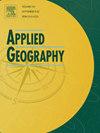Spatio-temporal heterogeneity and influencing factors in the synergistic enhancement of urban ecological resilience: Evidence from the Yellow River Basin of China
IF 4
2区 地球科学
Q1 GEOGRAPHY
引用次数: 0
Abstract
Urban ecological resilience (UER) reflects the ability of cities to adapt to environmental changes and cope with natural disasters. Further, UER is an important perspective for understanding human–land relations in the Yellow River Basin (YRB). We constructed a novel system of UER evaluation indicators from the perspective of synergistic enhancement, with 99 cities in the YRB as objects for the research conducted from 2011 to 2021. The spatiotemporal heterogeneity and network pattern of UER were measured using the Theil index and modified gravity model. The factors influencing UER in the YRB were analysed using a multiscale geographically weighted regression model. The results show that (1) regarding time-series analysis, the UER in the YRB shows a fluctuating upward trend from 20.89 in 2011 to 26.23 in 2021, with the contribution of ecological image being the largest. The UER at different reaches, urban agglomerations, and cities varied considerably. (2) Regarding spatial analysis, the UER has a ‘center-periphery’ spatial distribution pattern dominated by provincial capital cities. The spatial network shows a '几'-shaped distribution pattern similar to the YRB mainstream distribution. Regarding UER connectivity, the ability for cross-regional joint development has improved. (3) The main influencing factors were urbanisation rate, education level, Normalized Difference Vegetation Index, and upgrading of the industrial structure, which represent urban development progress and geographical ecological characteristics. This study expands UER measurement and provides a basis and reference for synergistic enhancement of UER in the YRB.
协同增强城市生态复原力的时空异质性及其影响因素:来自中国黄河流域的证据
城市生态复原力(UER)反映了城市适应环境变化和应对自然灾害的能力。此外,UER 还是理解黄河流域人地关系的重要视角。我们以黄河流域 99 个城市为研究对象,从协同增效的角度构建了一套新颖的 UER 评价指标体系,研究时间跨度为 2011 年至 2021 年。采用 Theil 指数和修正的引力模型对 UER 的时空异质性和网络格局进行了测量。采用多尺度地理加权回归模型分析了影响长滩区 UER 的因素。结果表明:(1) 从时间序列分析,长江河段 UER 呈波动上升趋势,从 2011 年的 20.89 升至 2021 年的 26.23,其中生态形象的贡献最大。不同河段、城市群和城市的 UER 相差较大。(2) 从空间分析来看,UER 呈现以省会城市为主的 "中心-外围 "空间分布格局。空间网络呈 "几 "字形分布,与长三角主流分布相似。在 UER 连接方面,跨区域联合发展的能力有所提高。(3) 城市化率、教育水平、归一化差异植被指数和产业结构升级是主要影响因素,代表了城市发展进程和地理生态特征。本研究拓展了 UER 的测量方法,为协同提升长三角地区的 UER 提供了依据和参考。
本文章由计算机程序翻译,如有差异,请以英文原文为准。
求助全文
约1分钟内获得全文
求助全文
来源期刊

Applied Geography
GEOGRAPHY-
CiteScore
8.00
自引率
2.00%
发文量
134
期刊介绍:
Applied Geography is a journal devoted to the publication of research which utilizes geographic approaches (human, physical, nature-society and GIScience) to resolve human problems that have a spatial dimension. These problems may be related to the assessment, management and allocation of the world physical and/or human resources. The underlying rationale of the journal is that only through a clear understanding of the relevant societal, physical, and coupled natural-humans systems can we resolve such problems. Papers are invited on any theme involving the application of geographical theory and methodology in the resolution of human problems.
 求助内容:
求助内容: 应助结果提醒方式:
应助结果提醒方式:


